Goodbye to a Gentleman Cat

Red went to the Rainbow Bridge on Thursday. So far, Daisy seems to be taking her buddy's absence in stride -- better than the humans in the house.
Having him euthanized was the toughest decision I've ever made. I wanted to make sure I was doing it for him. Mary and I had talked it over for weeks, and especially over the past few days, when his decline accelerated.
He still ate and drank, though little. He still enjoyed the outdoors, though for the past few days I was mainly holding him in my arms and walking him around the yard. When he squirmed to be let down, he struggled to walk, stumbling and falling. Back in October he weighed a bit over 11 pounds. By last month he had dropped to 8. On Thursday it was 7. He had more accidents around the house, solid and liquid. Even when we delivered him to a newly-cleaned litter box, he couldn't stand in it. According to our vet, we had been giving him hospice care.
It was time. And it was hard. Mary and I stayed with Red throughout, and the clinic staff was wonderful. Red passed very peacefully as Mary and I petted him and reminisced to the vet and his assistant about better times. That kind of talk was just what I needed, so that I could say goodbye without falling completely apart. I was most worried that Red would pick up on my upset and my grief, when I wanted my vibes to be those of love and calm....(continues)
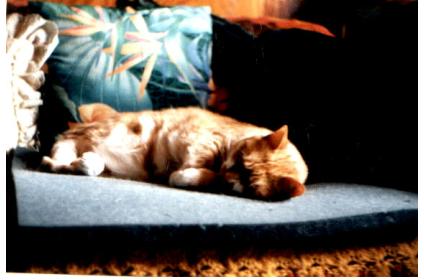
Red, shortly after he came into my life and Daisy's. He is about a year old in this picture, taken in my living room in Cambridge, MA.
The gentlest cat I have ever known came into my life in December 1992. The tag on his cage at the Boston Animal Rescue League shelter read that he was eight months old, and that he had been in the shelter for two weeks.
I'd had Daisy since July of that year. She was 12 weeks old when I got her, which meant that she and Red were just about the same age. Daisy had been a diva cat from the beginning, but I was off working during the day and she was clearly lonely. I set out to find her a companion whose laid-back temperament complemented her controlling personality.
Any visit to a shelter is heartbreaking -- so many clamoring for a home, for love, for a few minutes out of the cage. The cat in the cage next to Red's strained against the bars. Red just sat in his own cage, looking sad. When he saw me he stepped up calmly to the front. I leaned in close. He gave me a soulful look, then slowly extended his paw between the bars and laid it, his untrimmed claws completely retracted, against my cheek. I knew then that I had found a companion for my diva.
My Cambridge apartment had a shotgun hallway and enough doors to close off a section of it. I restricted Daisy to one end of the apartment, set up Red in the other, and turned the closable section of hallway into "the neutral zone." For three days each cat took turns in the neutral zone to learn each other's scent. Every chance she got, Daisy hissed at Red from the other side of whatever closed door separated them. Whenever I was with one cat the other one called me, and I spent sleepless nights shuffling between Daisy on the bed and Red on the sleeper couch.
At some point Daisy scooted past my legs into Red's end of the apartment and hissed a blue streak. He took one look at her and flopped onto his back. In a moment they were best buddies, chasing each other up and down the hallway. Mary, who moved in with us four years later, called it "swapping engine and caboose."
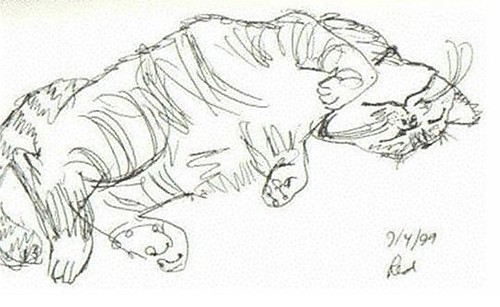
A sketch I made of Red in 1999.
I called Red my hedonism guru. He was "a sponge for love," to quote Marge Piercy's poem "Cho-Cho." Anybody with a lap was his friend. Mary also noticed right off that if Red miscalculated a jump (especially if the target inadvertently moved) and was about to floop, he let himself fall rather than dig his claws into a pants leg. She also noticed that Red cringed whenever she innocently lifted a small stick to ring a chime that hung in the apartment. During the first few years that Red was with me, he shrank back whenever I lifted a hand to pet him. Mary and I concluded that he'd been abused as a kitten. It took years for him to overcome the urge to cringe, and for him to cultivate a raised "happy tail," rather than one that dipped down between his legs.
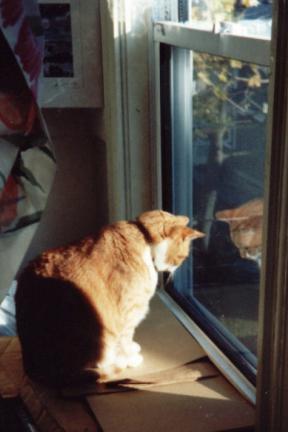
At our kitchen window in Dorchester, MA.
M had designed "heated cat beds" for both the living room and our bedroom in Dorchester. The stacking design of open-top plastic storage bins that we'd rescued from the curb gave them "legs" a couple of inches long. The plastic was not solid but cross-hatched, providing ventilation. Mary had fitted old sweaters into the bins and placed each over a heating grate. Their legs allowed for air flow to the rest of the room while the cats snuggled in what must have been the warmest spots in the apartment.
Red is about seven years old in this photo at the window. We don't know how many of his nine lives he'd gone through before he came into ours, but he passed another one when we almost lost him in 1999. He couldn't keep anything down, solid or liquid, and became dehydrated. We rushed him to our Boston vet for subcutaneous fluids. Finally we checked him into Angell Memorial Hospital. All that the vets there could tell us was that at about his age, large tawny cats sometimes came down with that condition, whatever that condition was.
He was in the hospital for six days, fed through a naso-gastric tube until he could eat and keep his food down. In the few short days before he began his recovery, his weight had dropped from 16 to 14 pounds.
Three years later, in October 2002, we almost lost him again. Our landlord was having the house insulated, Mary and I were both down with bad colds, I was struggling through mine at work, and Mary was at home cleaning up the messes the insulation installers had left behind. Our entrance to the house was in the back, through a door that never closed properly. Red found his way outside and went missing for four days.
We put up signs. We patrolled the neighborhood carrying tuna and left more food outside. We found one dead cat in the road near home, hit by a car, but although its coloring looked like Red's it had six toes. Another neighbor e-mailed us a photo of another dead cat he had seen, and it looked enough like Red to have us convinced we'd lost our boy. But that, too, was a different cat.
Daisy, who was far wiser than either of us, kept meowing at the closet beneath the eaves. Red wasn't there, but he had been sheltering deep inside bushes below that spot, and Daisy could smell him. By the time Red emerged from his hiding place, he had been stung on his face by a hornet. After a few days of eating, he was suddenly in too much pain as his face swelled and his temperature shot up to 105 degrees. A cat's normal temperature is 101.
While I was stuck in the office, Mary spent a solid month force-feeding him by stopper, using a formula in one of our cat care books. At first, Red was a rag doll -- more limp even than he had been on his last day alive. We could tell he was getting better when he began fighting the force-feeding. Eventually he resumed eating on his own and was well on the road to recovery in November 2002 -- right when my father died.
Four months later, Mary and I and the cats were on the road to Florida, shooting down the East Coast in a rental van and staying at pet-friendly motels.
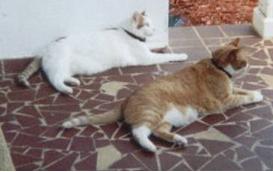
Daisy and Red, 11 years old, on our front porch in Florida, March 2003.
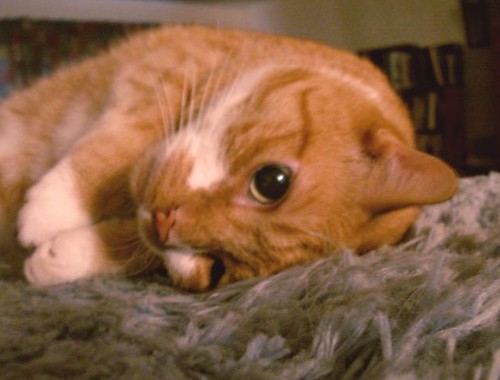
October 2005: Red gets comfortable on a shag carpet atop one of our filing cabinets.
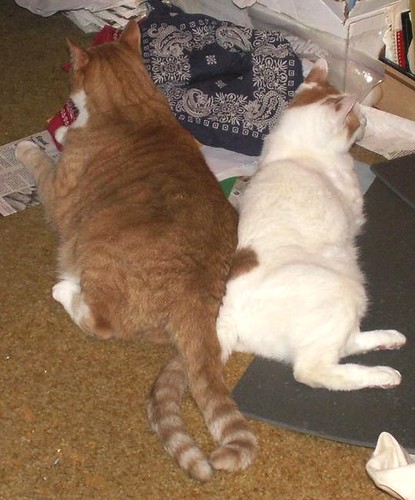
May 2006: A Tail of Two Kitties
Red's weight had increased to almost 19 pounds -- what Mary called "a balloon with fur." We were told to put him on a diet and get him down to 12 pounds, and it was torture for all of us. He'd already weighed 13 pounds when I first got him from the shelter in 1992. When he got down to 14.5 pounds we switched him to a maintenance diet. We had no idea how much his weight would plummet and in how short a time just a couple of years later.
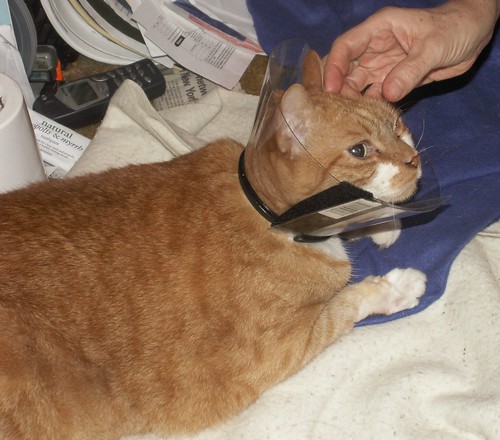
By May 2007, a button-shaped growth had swelled and was seeping on Red's front right paw. We had it removed, and his paw recovered quickly, but soon his rear legs began giving him trouble.
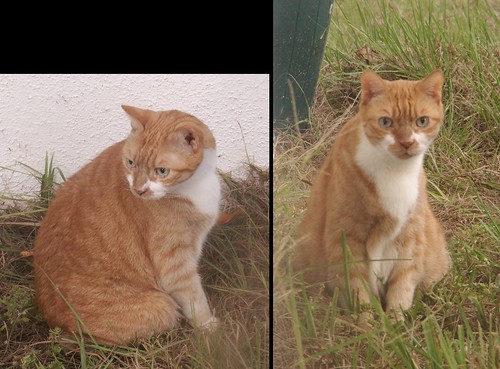
By October of last year, Red's weight had fallen to a bit over 11 pounds and he began to have trouble walking. His rear knees kept coming out of joint, or at least that's what it looked like to us. One vet diagnosed a bad case of arthritis. Another diagnosed a congenital condition that didn't show up until advanced age. By the time I took this pair of photos in our back yard, Red's decline had begun. We had a senior wellness panel done on him in October and then again last month. Elevated calcium readings pointed to possible cancer. Elevated pancreatic readings pointed to possible pancreatitis, something that the vet on Thursday thought might have played a role in Red's long-ago hospitalization. Such tests weren't generally conducted then.
At Red's age, we were told that any invasive procedures would probably do more harm than good. Mary and I entered, gradually but more and more deeply, into a death watch mode. Our top priority was to keep Red as comfortable as we could.
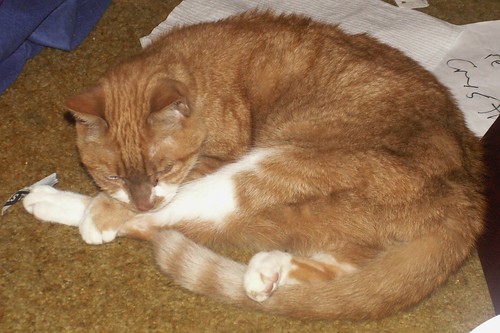
I took this photo of Red on the last day of his life. I spent much of his last night holding him, except for when he wanted to go back down on the rug. Sometimes, no matter how gently I set him down, he flopped to the floor and spent a minute marshaling his strength before he could stand. He'd spent the last few weeks of his life alternating between frailty and a temporary rallying, even on Thursday. For all his suffering he still had some spirit left, and that made my decision especially hard. As Mary put it, we had entered into an experiment to see how much longer we could keep him alive. I didn't know if I was condemning him to death too quickly or prolonging his suffering for too long. I knew only that I wanted to do right by him.
Mary said, "He's done everything that we've asked him to do."
I called and consulted with the vet, who said that it can be very hard to tell with cats. They are stoic, they don't tell you when they're in pain, and they (and other animals) rally. We had to ask ourselves the question: how far down has Red's quality of life gone from what we would consider his normal state? Most people tended to choose euthanasia when that figure dropped below 50 percent.
M and I agreed that Red's quality of life was considerably below 50 percent of what it had been. When the vet said that we were effectively providing hospice care, we agreed that it was time to let him go.
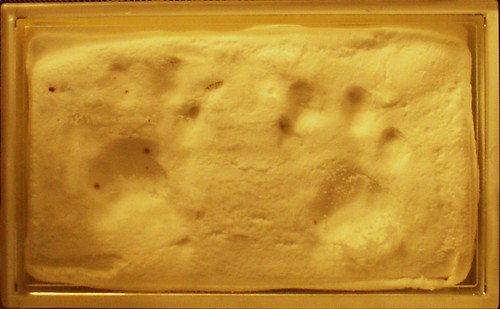
Imprints of Red's front paws, taken after death.
Red
1992-2008
Goodbye, old friend.
 | Covenant, the first volume in the Deviations Series, is available from Aisling Press, and from AbeBooks, Amazon, Barnes and Noble, Book Territory, Borders, Buecher.ch, Buy.com, DEAstore, libreriauniversitaria.it, Libri.de, Loot.co.za, Powell's Books, and Target. The Deviations page has additional details. |











0 Comments:
Post a Comment
<< Home